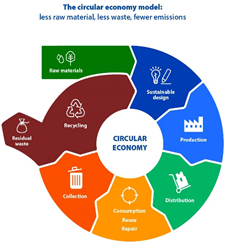

Context
Global plastic pollution can reduce by 80 per cent by 2040 if countries and companies make deep policy and market shifts using existing technologies and shift to a circular economy, according to a new report launched by United Nations Environment Programme (UNEP).
Key-highlights of the Report
- Title:Turning off the Tap: How the world can end plastic pollution and create a circular economy
- Circular economy approach: The report urged governments and businesses alike to adopt a circular economy approach for tackling the problem of plastic pollution.
- Cut down on plastic: Countries need to eliminate unnecessary and problematic plastic uses.
- Shift: They need to make three market shifts — reuse, recycle, and reorient and diversify.
- Even with the above measures, 100 million tonnes of plastics from single-use and short-lived products will still need to be safely dealt with annually by 2040 — together with a significant legacy of existing plastic pollution.
- However, any delays in executing the necessary shifts will mean higher costs and an additional 80 million tonnes of plastic pollution by 2040.
How would this shift benefit the economy?
- Savings: Overall, the shift to a circular economy would result in $1.27 trillion in savings, considering costs and recycling revenues.
- Reduced expenditure on externalities: A further $3.25 trillion would be saved from avoided externalities such as health, climate, air pollution, marine ecosystem degradation, and litigation-related costs.
- Increased employment opportunities: This shift could also result in a net increase of 700,000 jobs by 2040.
What is Circular economy?
- Circular economy is an economic model that aims to minimize waste and maximize resource efficiency by keeping products, materials, and resources in use for as long as possible.
- It is a departure from the traditional linear economy, which follows a "take-make-dispose" pattern.
- In a circular economy, resources are kept in circulation through strategies such as recycling, reuse, remanufacturing, and sharing, creating a closed-loop system.

|
Environmental Benefits |
Economic Benefits |
Social Benefits |
|
|
|
Government recent initiative to promote circular economy and sustainable growth
The Union Budget 2023-24 has put the focus on sustainable development and a circular economy
- GOBARdhan: The scheme aims to promote a circular economy by setting up 500 “waste-to-wealth” plants across the country, including 200 compressed biogas (CBG) plants and 300 community-based plants. The goal is to convert waste into valuable resources, reducing the country’s carbon footprint and promoting sustainability.
- Mangrove Initiative for Shoreline Habitats & Tangible Incomes (MISHTI): MISHTI aims to preserve and restore the mangrove ecosystem and provide livelihood opportunities for local communities.
- Promoting Conservation Values: Amrit Dharohar: It aims to promote the conservation of wetlands in the country.
- Plastic Waste Management (Second Amendment) Rules, 2022: They mandate to increase in the thickness of plastic carry bags to over 120 microns, and the phase-out of some single-use plastic products.
What are the present challenges?
- Limited Infrastructure and Technology
- Complex Supply Chains
- Policy and Regulatory Hurdles
- Consumer Mindset and Behavior

